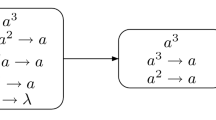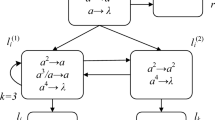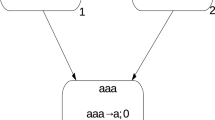Abstract
Spiking neural P systems with multiple channels (SNP-MC systems, for short) are a kind of distributed parallel computing devices, inspired by the way that neurons communicate by means of spikes as well as one or more synaptic channels. SNP-MC systems working in synchronous mode have been investigated. This paper discusses SNP-MC systems working in sequential mode, i.e., sequential SNP-MC systems (SSNP-MC systems, for short). The combination of two sequential sub-modes and two strategies of rule application is considered, that is, four sequentiality strategies. It is proven that SSNP-MC systems working in four sequentiality strategies are Turing universal number generating and accepting devices, respectively.










Similar content being viewed by others
Explore related subjects
Discover the latest articles, news and stories from top researchers in related subjects.References
Ionescu, M., Păun, G., & Yokomori, T. (2006). Spiking neural P systems. Fundamenta informaticae 71(2-3):279–308
Păun, G. (2000). Computing with membranes. Journal of Computer and System Sciences, 61(1), 108–143.
Păun, G., Rozenberg, G., & Salomaa, A. (2010). The Oxford handbook of membrane computing. New York: Oxford University Press.
Păun, G. (2007). Spiking neural P systems with astrocyte-like control. Journal of Universal Computer Science, 13(11), 1707–1721.
Pan, L., Wang, J., & Hoogeboom, H. J. (2012). Spiking neural P systems with astrocytes. Neural Computation, 24(3), 805–825.
Pan, L., & Păun, G. (2009). Spiking neural P systems with anti-spikes. International Journal of Computers Communications & Control, 4(3), 273–282.
Song, T., Pan, L., & Păun, G. (2014). Spiking neural P systems with rules on synapses. Theoretical Computer Science, 529, 82–95.
Song, T., & Pan, L. (2015). Spiking neural P systems with rules on synapses working in maximum spiking strategy. IEEE Transactions on Nanobioscience, 14(4), 465–477.
Peng, H., Chen, R., Wang, J., Song, X., Wang, T., Yang, F., & Sun, Z. (2017). Competitive spiking neural P systems with rules on synapses. IEEE Transactions on NanoBioscience, 16(8), 888–895.
Song, T., & Pan, L. (2016). Spiking neural P systems with request rules. Neurocomputing, 193, 193–200.
Cabarle, F. G. C., Adorna, H. N., Pérez-Jiménez, M. J., & Song, T. (2015). Spiking neural P systems with structural plasticity. Neural Computing and Applications, 26(8), 1905–1917.
Wu, T., Păun, A., Zhang, Z., & Pan, L. (2017). Spiking neural P systems with polarizations. IEEE Transactions on Neural Networks and Learning Systems, 29(8), 3349–3360.
Pan, L., Păun, G., Zhang, G., & Neri, F. (2017). Spiking neural P systems with communication on request. International Journal of Neural Systems, 27(08), 1750042.
Peng, H., & Wang, J. (2018). Coupled neural P systems. IEEE Transactions on Neural Networks and Learning Systems, 30(6), 1672–1682.
Peng, H., Wang, J., Pérez-Jiménez, M. J., & Riscos-Núñez, A. (2019). Dynamic threshold neural P systems. Knowledge-Based Systems, 163, 875–884.
Peng, H., Li, B., Wang, J., Song, X., Wang, T., Valencia-Cabrera, L., Pérez-Hurtado, I., Riscos-Núñez, A., & Pérez-Jiménez, M. J. (2020a). Spiking neural P systems with inhibitory rules. Knowledge-Based Systems, 188, 105064.
Peng, H., Bao, T., Luo, X., Wang, J., Song, X., Riscos-Núñez, A., & Pérez-Jiménez, MJ. (2020). Dendrite P systems. Neural Networks 127:110–120
Peng, H., Lv, Z., Li, B., Luo, X., Wang, J., Song, X., et al. (2020). Nonlinear spiking neural P systems. International Journal of Neural Systems, 30(10), 2050008 (1-17).
Cabarle, F., Zeng, X., Murphy, N., Song, T., Rodríguez-Patón, A., & Liu, X. (2021). Neural-like P systems with plasmids. Information and Computation, 1, 104766.
Peng, H., Wang, J., Pérez-Jiménez, M. J., Wang, H., Shao, J., & Wang, T. (2013). Fuzzy reasoning spiking neural P system for fault diagnosis. Information Sciences, 235, 106–116.
Wang, J., Shi, P., Peng, H., Pérez-Jiménez, M. J., & Wang, T. (2012). Weighted fuzzy spiking neural P systems. IEEE Transactions on Fuzzy Systems, 21(2), 209–220.
Wu, T., & Jiang, S. (2021). Spiking neural P systems with a flat maximally parallel use of rules. Journal of Membrane Computing, 3, 221–231.
Cruz, R., Cabarle, F., & Adorna, H. (2019). Generating context-free languages using spiking neural P systems with structural plasticity. Journal of Membrane Computing, 1, 161–177.
Zhang, G., Rong, H., Neri, F., & Pérez-Jiménez, M. J. (2014). An optimization spiking neural P system for approximately solving combinatorial optimization problems. International Journal of Neural Systems, 24(05), 1440006.
Wang, T., Zhang, G., Zhao, J., He, Z., Wang, J., & Pérez-Jiménez, M. J. (2014). Fault diagnosis of electric power systems based on fuzzy reasoning spiking neural P systems. IEEE Transactions on Power Systems, 30(3), 1182–1194.
Peng, H., Wang, J., Shi, P., Pérez-Jiménez, M. J., & Riscos-Núñez, A. (2017a). Fault diagnosis of power systems using fuzzy tissue-like P systems. Integrated Computer-Aided Engineering, 24(4), 401–411.
Peng, H., Wang, J., Ming, J., Shi, P., Pérez-Jiménez, M. J., Yu, W., & Tao, C. (2017b). Fault diagnosis of power systems using intuitionistic fuzzy spiking neural P systems. IEEE Transactions on Smart Grid, 9(5), 4777–4784.
Wang, J., Peng, H., Yu, W., Ming, J., Pérez-Jiménez, M. J., Tao, C., & Huang, X. (2019). Interval-valued fuzzy spiking neural P systems for fault diagnosis of power transmission networks. Engineering Applications of Artificial Intelligence, 82, 102–109.
Díaz-Pernil, D., Peña-Cantillana, F., & Gutiérrez-Naranjo, M. A. (2013). A parallel algorithm for skeletonizing images by using spiking neural P systems. Neurocomputing, 115, 81–91.
Díaz-Pernil, D., Gutiérrez-Naranjo, M. A., & Peng, H. (2019). Membrane computing and image processing: A short survey. Journal of Membrane Computing, 1(1), 58–73.
Li, B., Peng, H., Wang, J., & Huang, X. (2020). Multi-focus image fusion based on dynamic threshold neural P systems and surfacelet transform. Knowledge-Based Systems, 196(105794), 1–12.
Li, B., Peng, H., & Wang, J. (2021a). A novel fusion method based on dynamic threshold neural P systems and nonsubsampled contourlet transform for multi-modality medical images. Signal Processing, 178(107793), 1–13.
Li, B., Peng, H., Luo, X., Wang, J., Song, X., Pérez-Jiménez, M. J., & Riscos-Núñez, A. (2021). Medical image fusion method based on coupled neural P systems in nonsubsampled shearlet transform domain. International Journal of Neural Systems, 31(1), 2050050 (1-17).
Cavaliere, M., Ibarra, O. H., Păun, G., Egecioglu, O., Ionescu, M., & Woodworth, S. (2009). Asynchronous spiking neural P systems. Theoretical Computer Science, 410(24–25), 2352–2364.
Song, T., Zou, Q., Liu, X., & Zeng, X. (2015). Asynchronous spiking neural P systems with rules on synapses. Neurocomputing, 151, 1439–1445.
Cabarle, F. G. C., Adorna, H. N., & Pérez-Jiménez, M. J. (2015). Asynchronous spiking neural P systems with structural plasticity. In: International Conference on unconventional computation and natural computation, Springer, 9252, 132–143.
Ibarra, O. H., Woodworth, S., Yu, F., & Păun, A. (2006). On spiking neural P systems and partially blind counter machines. In: International Conference on Unconventional Computation, Springer, 4135, 113–129.
Ibarra, O. H., Păun, A., & Rodríguez-Patón, A. (2009). Sequential SNP systems based on min/max spike number. Theoretical Computer Science, 410(30–32), 2982–2991.
Zhang, X., Luo, B., Fang, X., & Pan, L. (2012). Sequential spiking neural P systems with exhaustive use of rules. BioSystems, 108(1–3), 52–62.
Zhang, X., Zeng, X., Luo, B., & Pan, L. (2014). On some classes of sequential spiking neural P systems. Neural Computation, 26(5), 974–997.
Song, T., Pan, L., Jiang, K., Song, B., & Chen, W. (2013). Normal forms for some classes of sequential spiking neural P systems. IEEE Transactions on Nanobioscience, 12(3), 255–264.
Jiang, K., Song, T., & Pan, L. (2013). Universality of sequential spiking neural P systems based on minimum spike number. Theoretical Computer Science, 499, 88–97.
Cabarle, F. G. C., Adorna, H. N., & Pérez-Jiménez, M. J. (2016). Sequential spiking neural P systems with structural plasticity based on max/min spike number. Neural Computing and Applications, 27(5), 1337–1347.
Bao, T., Zhou, N., Lv, Z., Peng, H., & Wang, J. (2020). Sequential dynamic threshold neural P systems. Journal of Membrane Computing, 2, 255–268.
Peng, H., Yang, J., Wang, J., Wang, T., Sun, Z., Song, X., Luo, X., & Huang, X. (2017). Spiking neural P systems with multiple channels. Neural Networks, 95, 66–71.
Song, X., Peng, H., Wang, J., Ning, G., Wang, T., Sun, Z., & Xia, Y. (2018). On small universality of spiking neural P systems with multiple channels. In: International Conference on Membrane Computing, Springer, 378, 229–245.
Song, X., Wang, J., Peng, H., Ning, G., Sun, Z., Wang, T., & Yang, F. (2018b). Spiking neural P systems with multiple channels and anti-spikes. Biosystems, 169, 13–19.
Acknowledgements
The authors thank the anonymous reviewers for providing very insightful and constructive suggestions, which have greatly help improve the presentation of this paper.
Author information
Authors and Affiliations
Corresponding author
Ethics declarations
Conflicts of interest
The authors declare that they have no conflict of interest.
Additional information
Publisher's Note
Springer Nature remains neutral with regard to jurisdictional claims in published maps and institutional affiliations.
This work was partially supported by the National Natural Science Foundation of China (No. 62076206 and No. 62176216), China.
Rights and permissions
About this article
Cite this article
Lv, Z., Yang, Q., Peng, H. et al. Computational power of sequential spiking neural P systems with multiple channels. J Membr Comput 3, 270–283 (2021). https://doi.org/10.1007/s41965-021-00089-9
Received:
Accepted:
Published:
Issue Date:
DOI: https://doi.org/10.1007/s41965-021-00089-9




